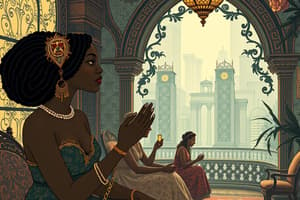Podcast
Questions and Answers
Which event sparked the six nights of disorder in Harlem and the death of one resident?
Which event sparked the six nights of disorder in Harlem and the death of one resident?
- The signing of the Civil Rights Act of 1964
- The taunting of police officers
- The murder of a high school student (correct)
- The burning and plunder in department and grocery stores
Which city experienced the largest and most destructive riot that summer?
Which city experienced the largest and most destructive riot that summer?
- Philadelphia
- Brooklyn
- Harlem
- Rochester (correct)
What did the uprisings during the summer of 1964 expose?
What did the uprisings during the summer of 1964 expose?
- Tensions between law enforcement officers and residents in segregated urban neighborhoods
- The history of police brutality and vigilante violence
- The ways in which discriminatory policing shaped black urban life (correct)
- All of the above
What did policymakers and the general public refer to as 'rioting'?
What did policymakers and the general public refer to as 'rioting'?
Which city experienced similar incidents after the disorder in Harlem and Brooklyn?
Which city experienced similar incidents after the disorder in Harlem and Brooklyn?
What was the sign that the social conditions that fomented unrest weren't specific to major metropolitan centers?
What was the sign that the social conditions that fomented unrest weren't specific to major metropolitan centers?
Which of the following is true about the legacy of Emancipation?
Which of the following is true about the legacy of Emancipation?
What did Johnson believe was the immediate overriding issue in New York?
What did Johnson believe was the immediate overriding issue in New York?
What did Johnson view the actions of black residents during the summer of 1964 as?
What did Johnson view the actions of black residents during the summer of 1964 as?
What was the purpose of Johnson's Law Enforcement Assistance Act of 1965?
What was the purpose of Johnson's Law Enforcement Assistance Act of 1965?
Why did Johnson turn to the War on Crime?
Why did Johnson turn to the War on Crime?
What were the punitive measures included in Johnson's Great Society based on?
What were the punitive measures included in Johnson's Great Society based on?
Who was the driving force behind the creation of Kennedy's Task Force on Manpower Conservation?
Who was the driving force behind the creation of Kennedy's Task Force on Manpower Conservation?
When did Kennedy convene the task force?
When did Kennedy convene the task force?
Which report did Wirtz deliver to Johnson?
Which report did Wirtz deliver to Johnson?
What connections did the task force draw between?
What connections did the task force draw between?
What did the task force argue would happen without federal intervention?
What did the task force argue would happen without federal intervention?
What did Moynihan believe provided an opportune moment to advocate for new federal employment measures?
What did Moynihan believe provided an opportune moment to advocate for new federal employment measures?
Which term did Moynihan use to describe the impact of social ills on individual behavior?
Which term did Moynihan use to describe the impact of social ills on individual behavior?
According to Moynihan, what could disrupt the 'tangle of pathology' in black communities?
According to Moynihan, what could disrupt the 'tangle of pathology' in black communities?
Flashcards are hidden until you start studying




